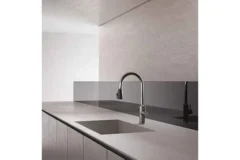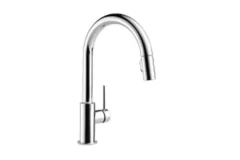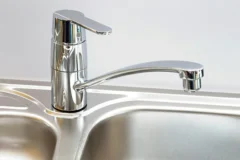A stainless steel flexible hose is a type of pipe that serves as a connection between two places. It performs the function of fluid transfer at both ends. Stainless steel is a metallic alloy of some strong metals, making it corrosion-free. Flexible hoses are among the products that we use every day. They are easy to install and last longer, making them a great fit. Their adaptive structure ensures endurance, which counts a lot. To completely understand the product, here is its meaning and definition.

Standard Types of Stainless Steel Flexible Hose:
Based on their structure and application, flexible hoses are of two kinds.
Corrugated Hose:
- Corrugated hoses contain long absorbing expansion joints. The working of a corrugated hose depends upon the working of the expansion joints in it. It’s hard for hoses to withstand longitudinal pressure and circular pressure. These resistances can make the hose slide due to internal stress.
- To avoid these problems, the corrugated hoses contain a braid wrapping outside. This feature enables the hose to undergo and sustain significant pressure changes. But a non-braided valve cannot endure much pressure. This wrapping also protects the hose from wear and tear.
- One should not bend a corrugated hose above its bearing level. Otherwise, it can cause trouble. There is one flaw in this type of flexible hose. The damage in braided valves does not show earlier because corrugations are invisible. That is why they are not very good for manual handling.
- Corrugated hoses are pressure-tight due to their long metallic walls. So, one should use them to flow ggasesnd liquids ftcompatible withndly to the hose material.

Interlocked Hose:
- Interlocked hoses have their mmaterials woundtogether. Their adjacent edges appear as foldings to make convolutions. These hoses contain packing materials within the crease to avoid leakage. This packing works like a gasket. Due to the sliding action of the hose, interlocked hoses are very flexible. The changing turns on the inside and outside of the hose provide the most significant spaces for bending.
- The spaces are responsible for making axial movements that enhance axial circulations. This condition helps in releasing internal pressure in the hose. At the same time, the high internal pressure may cause damage. The outer surface of the hose is very smooth and does not need any coverings to handle.
- This type of hose is not suitable for carrying high-pressure fluid transfers. Yet, for low-pressuresteam nd water flow, we can regard them as the best option.
- The bending of the hose is limited to a certain level, and upon this, it gets stiff. This feature alarms the user to be careful in further bending. Thus, it goes exexcellentlyor manual handling. Therefore, it goes perfectly for manual handling.
In the realm of plumbing and industrial applications, stainless steel flexible pipe hoses are highly favored for their durability, flexibility, and resistance to corrosive elements. Here, we’ll unfold the various types of stainless steel flexible hoses and their inherent advantages for diverse applications.
All Types of Stainless Steel Hose
1. Corrugated Stainless Steel Hose:
Corrugated hoses exhibit a unique structure with annular or helical corrugations that enhance flexibility and pressure resistance.
- Advantages:
- High Flexibility: The corrugated design allows for a high degree of bendability.
- Pressure Resistance: Can withstand high pressures due to its robust construction.
2. Braided Stainless Steel Hose:
Braided hoses encompass a corrugated hose encased in a braided mesh, enhancing its strength and pressure capabilities.
- Advantages:
- Increased Strength: The braided mesh fortifies the hose, enabling it to handle higher pressures.
- Abrasion Resistance: The external braid protects the hose from abrasive elements.
3. PTFE-Lined Stainless Steel Hose:
These hoses have a smooth PTFE liner encased in a stainless steel outer braid, making them ideal for handling corrosive fluids and high temperatures.
- Advantages:
- Chemical Resistance: PTFE lining offers exceptional resistance to harsh chemicals.
- High-Temperature Tolerance: Suitable for applications involving high-temperature fluids.
4. Interlocked Stainless Steel Hose:

Interlocked hoses feature a construction where the metal strips are locked together, creating a hose with excellent crush and tensile strength.
- Advantages:
- Crush Resistance: Ideal for applications where the hose might be subjected to crushing forces.
- Tensile Strength: Exhibits high tensile strength, protecting against stretching and tearing.
5. Jacketed Stainless Steel Hose:
Jacketed hoses consist of an inner hose encased within an outer hose, used primarily for temperature maintenance or to provide a level of safety in case of leakage.
- Advantages:
- Temperature Maintenance: Insulates the inner hose to maintain the temperature of the conveyed fluid.
- Leak Prevention: In case of a leak in the inner hose, the outer hose provides a containment barrier.
6. Multi-Layered Stainless Steel Hose:
Multi-layered hoses consist of multiple layers of stainless steel with varying constructions to cater to specific requirements like high-pressure handling, temperature resistance, or corrosion resistance.
- Advantages:
- Versatility: Can be engineered to cater to a variety of challenging applications.
- Enhanced Capabilities: Multiple layers augment the hose’s pressure handling, thermal insulation, and chemical resistance properties.
Each type of stainless steel flexible pipe hose is crafted to serve distinct applications, whether in plumbing, heating, or industrial sectors. Understanding the unique attributes of each type helps in making an informed decision, catering to the specific requirements of a project. Plumberstar, with its extensive array of stainless steel flexible hoses, stands poised to provide solutions that align with the stringent quality and performance expectations, thereby aiding in the seamless functionality of systems and ensuring enduring satisfaction among its clientele.

Functions and Types of Flexible Hoses:
There are different functions of hoses. They vary depending on the material and structure. Below are the types of hoses in terms of materials and their functions.
- Stainless Steel Flexible Hose: It has the highest physical endurance of all hoses. Stainless steel is a metallic alloy. It can resist corrosion, heat, rusting, etc. They come in different types. We can install Stainless steel flexible hoses in bathrooms and kitchens. They are applicable in commercial plants and even in industries. It can survive atmospheric decay due to the presence of chromium.
You can see the applications of these hoses in the transfer of liquids, gases, oils, and water. Stainless steel makes the product equally valuable for both household and commercial uses.
Specifications:
Material: Stainless Steel
Medium: Liquid.
Temperature Range: 270°C to 600°C.
Bend Radius: 120mm.
Thread Size: 60mm.
Diameter: 14 mm.
Working Pressure: 7.5 MPa.
Maximum Pressure: 40Mpa.
Main Body Weight: 0.21kg/m.
● Rubber Hose: Rubber hoses are suitable for commercial and industrial uses. They perform the function of material transfer in air. They are fixed in specific directions. Continued flexing is not their feature.
Material: EPDM, Oil-Resistant Synthetic Rubber.
Size: 5 / 8 inch
Length: 12/15 feet.
Thread Size: 31/32″-20
Inner Diameter: 1-½
Temperature range: -40°C to +121°C.
Working Pressure: 1.55 MPa.
Burst Pressure: 6.2 MPa.
Gross Weight: 0.34 Kg.
Nut Size: 2 inches.

- Plastic Hose: Plastic hoses are suitable for industrial, agricultural, and construction purposes. They are very effective. Plastic hoses are chemical-resistant, and that’s why they can carry chemicals. They are also abrasion-resistant. Plastic hoses can easily carry liquids, granules, and powders.

Specifications:
Material: PVC.
Size: 3 /4 inches.
Length: 50/100 meters.
Thickness: 3mm.
Bend Radius: 40mm.
Thread Size: 11-1/2 per inch.
Temperature Range: -10 degrees Celsius to 65 degrees Celsius.
Working Pressure: 0.37 MPa.
Nut Size: 5 /8
From Mayfair Plumbing and Gasfitting
- Insulated Hose: They are very important in commercial ventilation systems. Insulated hoses need more endurance. They typically have a double-ply body between insulation layers. Their primary function is to insulate flexible hoses. Insulated hoses keep the temperature consistent. It can maintain the temperature state of liquid flowing and cold it.
Specifications:
Material: Stainless steel or fiberglass pipe.
Length: Varies.
Temperature Range: – 30°C to +110°C.
Thickness: 0.30mm
Thread Size: 2-1/2 per inch.
Medium: Liquid.
Inner Diameter: 7.0mm.
Working Pressure: 1.6 to 3.2 MPa.
Gross Weight: 0.040kg
Nut Size: 3 /4
- Aluminum Hose: Aluminum hose is very famous for its lightweight. It has less costly properties. It is widely popular due to high-temperature movements. It’s also corrosion-resistant and works for a long time. Aluminum hoses are best for industrial uses. They can handle sensitive materials such as chemicals. It can also be used for firefighting, marine, and protection uses.
Specifications:

Material: Aluminum.
Length: 1 meter to 5 meters is the standard length.
Size: 10mm to 50mm.
Diameter: 0.16mm
Thread Size: 1 /8 per inch.
Temperature Range: -100 degrees Celsius to +400 degrees Celsius.
Diameters: 50-750 mm.
Working Pressure: 1-4Mpa.
Nut Size: 1.5 Inches.
- Fabric Hoses: Fiber hoses are very convenient. They are budget-friendly and easy to carry. Fabric hoses have a long range of applications. They are helpful in blowers, printing machines, and engine warnings. We can also use them for the transmission of hot and cold water and in aircraft formation.
Specifications:
Material: Silicone Coated Glass Fabric.
Layers: Two layers.
Diameter: 50 to 200mm
Thread Size: 2.875
Temperature Range: -70 degrees Celsius to +400 degrees Celsius.
Size: 200mm to 500mm.
Working Pressure: 0.8 to 2.5 Mpa.
Nut Size: 1 /4 inches.
- Silicone Hose: Silicone can meet extremely high-temperature conditions. Therefore, they are ideal for industrial uses such as in heating processes. It has excellent resistance to chemicals. Sometimes, they can tolerate higher temperatures up to 500 degrees Fahrenheit.
Specifications:
Material: Silicone Rubber
Length: 20 meters per roll.
Size Range: 2mm to 350 mm.
Thread Size: 1 /6.
Wall Thickness: 4mm to 6mm.
Diameter: 30 to 50mm.
Temperature Range: -60 degrees Celsius to 300 degrees Celsius.
Working Pressure: 0.3 to 1.2 MPa
Burst Pressure: 2.5 MPa.
Gross Weight: 0.086kg
Nut Size: 2.5 inches.
Specifications and dimensions of Stainless Steel Flexible Hose:

A stainless steel flexible hose contains various properties which make it stand out. The following are the most attractive traits of flexible hoses.
- Flexible Nature:
As the name indicates, flexible hoses are a favorite due to their flexible nature. They provide enough space for bending. This feature is responsible for industrial use. Uneven paths create trouble, which we can treat using a flexible hose. It makes the flow of fluids efficient and quick.
- Corrosion Resistant:
When it comes to stainless steel flexible hose, stainless steel is an excellent metallic alloy. Its properties are more efficient than any other metal used. Stainless steel contains the combined effect of iron, chromium, and other metals. These metals have great corrosion-resistant power.
Besides this, the structure of the flexible hose is such that it saves steel wires from contacting water. So, due to less water exposure, the hose performs very well.
- Easy to Install:

Stainless steel flexible hoses are very easy to install. Usually, Separate parts are available that we connect to the line. Thus, it reduces the need for any riser base to be installed. This factor also reduces the hazards during the installation process.
- Reusability:
Adjustable valves are eco-friendly products. Industries can recycle them, and we can use them over and over. The recovery process adds some details to the worn-out parts, making them ready to reinstall. It’s no doubt a remarkable initiative to recycle old products.
- Modularity:
A flexible structure’s independent layers make it customized. It works as per the specific needs of a particular development. Only four layers make up simple, flexible pipes for medium-pressure water transfer.
The addition of Extra layers is to reduce wear between steel layers, making it work for the fluid barriers and stress-resistant wires.
Steel pipe already has a lower insulating coefficient than the typical flexible pipe.
- Pressure Resistance:
Stainless steel flexible pipe is widely known for its endurance. It can undergo high-pressure conditions. The hose structure enables it to bear internal and circular pressure as the bending area gives resistance to stress. All such properties make stainless steel flexible hose a perfect pressure-resistant product.
Installation Guide for Flexible Hose:
Knowing about the basic rules of installation is necessary. It teaches one to choose suitable approaches to enhance a flexible hose’s life span. Below are the critical factors for the successful setting up of the hose.

- Selection of the Right Product:
Before starting, you must consider buying a suitable product. Measure the length between two distant places where the hose is to be installed. You can choose either a plastic or stainless steel/metallic hose. Remember, a metallic hose is excellent for its life span, while a plastic hose is ideal for high-pressure conditions. So, choose the one that you desire.
Short lengths or wrong measurements can create leakages, which can be worse. Thus, making a compatible choice is the first demand for the final installment.
- Hose Radius Adjustments:
It is an essential factor for the long-term working of hose pipes. The braided structure of the hose allows contractions through bending spaces. Here, the radius of the pipe should be suitable. If the hose does not contain enough room to turn, it will lose flexibility, and it can turn brittle. If the radial space is less than double the diameter, it can result in the loss of the internal body.
Thus, it is necessary to maintain the smooth flow via an adjusted radius.

- Excessive Hose Twisting:
Before installing the hose, get a deep checkup to see if there is any twist in the hose. The twists can create stress in the pipe and block the fluid pathway. So, try to straighten the hose piping and then set it up.
The movement of the hose in more than one plane is not a good sign. It should move in one plane in most cases. As the hose ends are firm, the two-dimensional motion can cause it to twist around, which you must set before installing.
- Layout Fixations:
When the outer layer of the hose wears out, it can disappear, which is a threat to the hose’s life. When the metallic lining comes into exposure to moisture, it rusts, which damages the working quality of the hose.
Clamping of hoses can save your day. It is the process of hose-shortening with pressure enforcement. Clamps should not be excessive. Instead, do it separately for every hose.
You are now moving forward to the main procedure. Start by turning off the water supply where you need to install the flexible hose—Wrap Teflon tape around the supply line faucet and the hose openings. Now, screw the nuts of one of the hose openings with the supply line opening. With the help of a tighter nut, tighten the nuts on both sides.
Wrap Teflon tape to the valve connected to the supply line. Connect the second opening of a hose pipe with the valve and tighten its screw. Use a wrench to ensure the right turns around. Check both fixations; if anyone is loose, fix it then and there.
Lastly, turn the water supply on to ensure no leakages. If there is any water leakage, reset the hose opening with the supply line. And you are done.
Remarks:
Stainless steel flexible hose is widely known in kitchens, bathrooms, and industries. They have excellent structural adaptations. Due to their rust-prevention nature, they lasted longer. Both plastic and metallic hoses are suitable, but stainless steel has a longer life span and better performance.
The stainless steel flexible hoses have taken the place of traditional pipes. They had fewer features and limited functions as compared to the hoses. Their easy-to-install nature and good quality have made these hoses a favorite product. You can list your desired qualities and get flexible hoses according to your needs.



